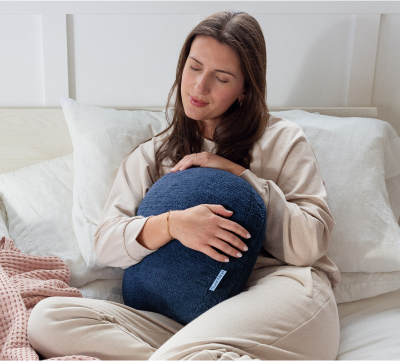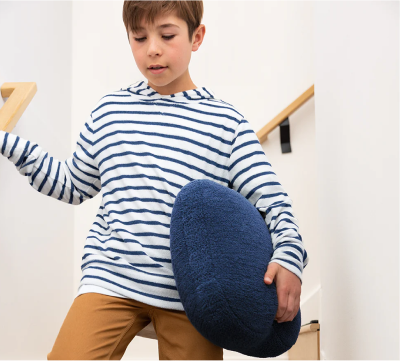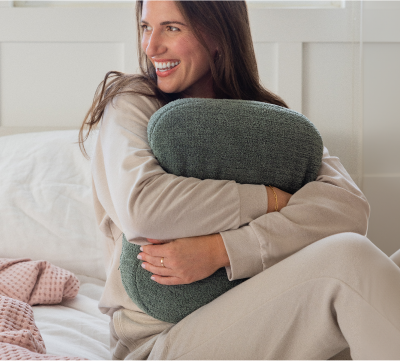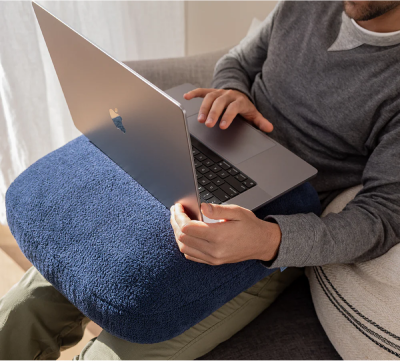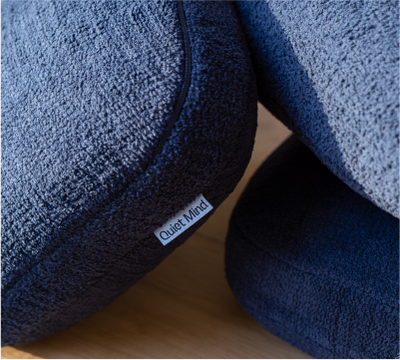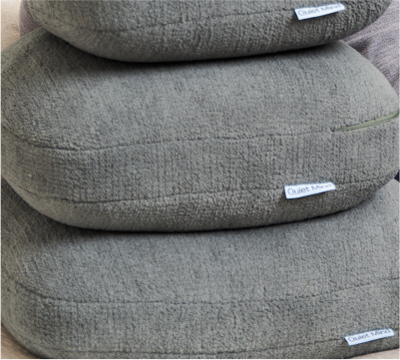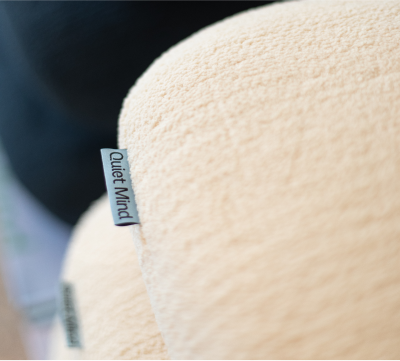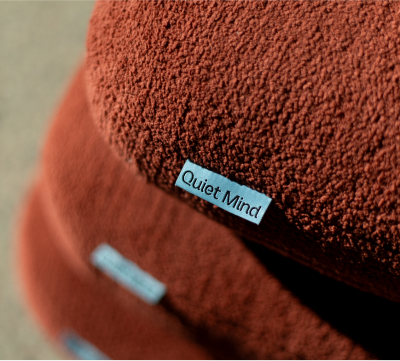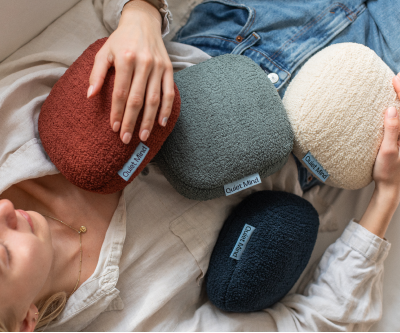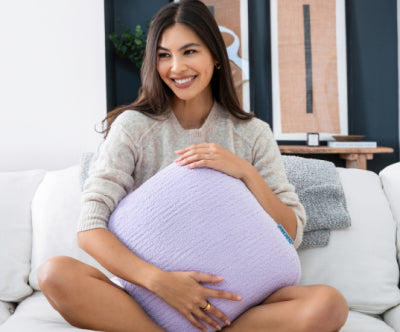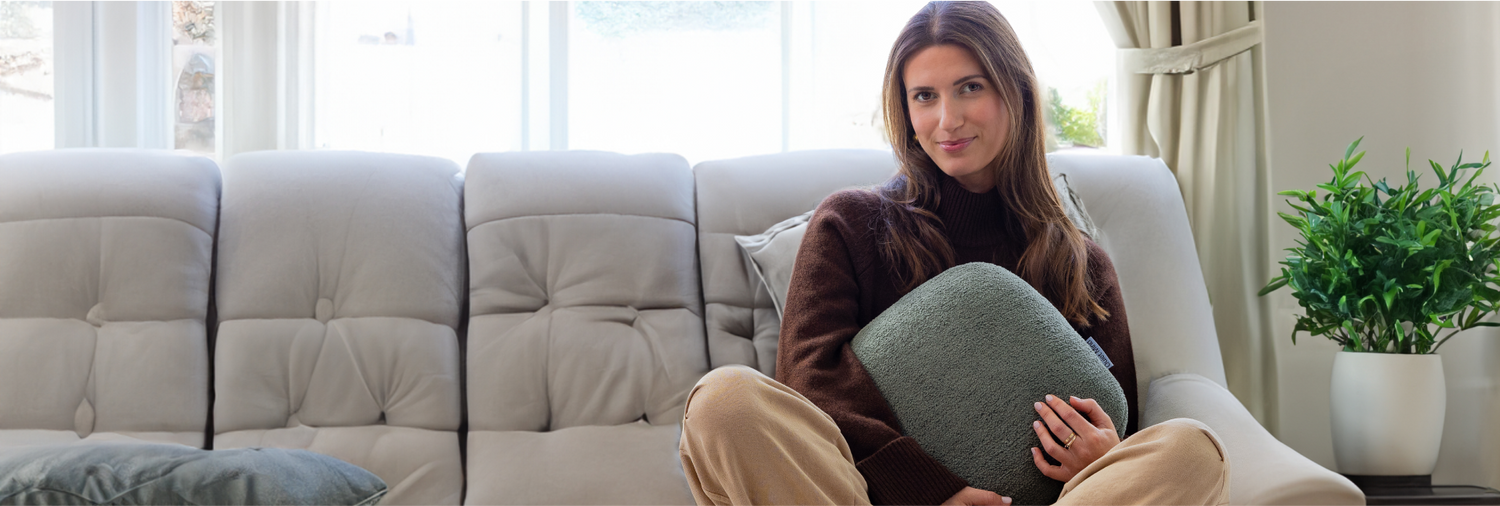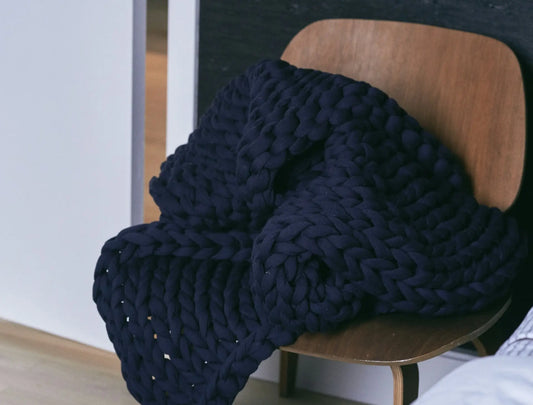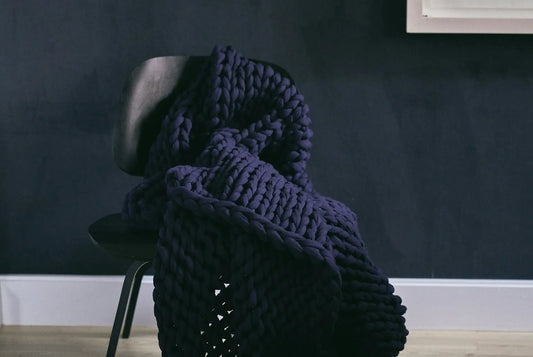Stillness comes easier when the body feels held. A weighted blanket offers gentle pressure that encourages a calming effect, helping many people fall asleep more easily and stay in deep sleep longer. But the position you sleep in with a weighted blanket matters, not just for comfort, but for your breathing, spinal alignment, and overall sleep quality.
Your sleeping position determines how the blanket’s weight is evenly distributed, how your joints respond, and how easily you can move or adjust during the night. For people managing stress and anxiety, insomnia, or restless leg syndrome, finding the right sleeping position with a weighted blanket can maximize its benefits while avoiding discomfort.
At the same time, pillows provide another solution. While blankets cover the whole body, a weighted pillow can be placed across your chest, lap, or shoulders, delivering the same deep pressure in a way that adapts to any sleep position.
Why Sleep Position Matters When You Sleep With a Weighted Blanket
Weighted blankets are designed to calm the nervous system through deep pressure stimulation, which is most effective when the blanket’s weight is evenly distributed across your body.
According to a study published in PubMed, weighted blankets were effective in reducing anxiety among adults in psychiatric facilities, making them a useful tool for promoting calm and enhancing sleep quality.
But your posture during sleep determines where the pressure settles, which joints bear the most weight, and how comfortable you remain over the course of the night.
How Pressure Distribution Shapes Comfort
When the weight is spread evenly, the blanket can work its magic without creating hot spots or pressure points. For example, lying on your back naturally distributes the weight across your torso, hips, and legs, offering the most balanced calming effect.
This can improve sleep quality by reducing micro-awakenings and increasing your chances of entering deep sleep.
|
Sleep Position |
Pressure Distribution |
Comfort Level |
Ideal For |
|
Back |
Even across the body |
High |
Relaxation, balanced pressure, better breath |
|
Side |
Uneven, focused on joints |
Variable |
Comfort seekers with joint support pillows |
|
Stomach |
Pressure on chest/abdomen |
Low |
Rare cases; not recommended for most users |
Weighted pillows allow for more personalized pressure distribution. If lying on your back feels too restrictive under a heavy blanket, a weighted pillow on the chest may mimic the calming input without affecting breathing.
Breathing, Alignment, and Joint Sensitivity
Your position affects:
-
Breathing capacity: Too much weight on the chest can limit airflow, especially in stomach sleeping.
-
Spinal alignment: Neutral posture supports joint health and prevents morning stiffness.
-
Movement restriction: Helpful for people who toss and turn, but can be uncomfortable if you feel confined.
Choosing a position that matches your body’s needs allows the weighted blanket to help without creating new discomforts.
Sleeping on Your Back: Is It the Ideal Position for Weighted Blankets?
For many, back sleeping is the most balanced way to sleep with a weighted blanket. Lying flat allows the blanket to evenly distribute its gentle pressure across the body, from the shoulders to the feet, without concentrating too much weight on one area.
Benefits: Balance, Alignment, and Stillness
This position offers several calming and restorative benefits:
-
Even Pressure: Encourages nervous system relaxation, helping to fall asleep faster and stay in deep sleep.
-
Spinal Alignment: Keeps your head, neck, and spine in a neutral position, which supports overall sleep quality.
-
Reduced Movement: A steady, contained feeling that helps calm overactive thoughts linked to stress and anxiety.
This position can be particularly supportive for people managing insomnia, anxiety disorders, or sensory processing issues, where predictability and stillness make it easier to sleep better.
Considerations: Snoring or Sleep Apnea
Back sleeping may worsen airway obstruction for some people with sleep apnea or chronic snoring. If you notice this:
-
Slightly elevate the head of your bed to improve airflow.
-
Use a wedge pillow to lift your upper body.
-
Consult your healthcare provider before long-term use.
Is It OK to Sleep on Your Side With a Weighted Blanket? Benefits for Side Sleepers
Yes, side sleeping can be deeply restorative when paired with the right weighted blanket. For many people, curling into a fetal position under gentle pressure creates a cocoon-like sense of safety that helps them fall asleep faster and stay relaxed through the night.
This position can be particularly beneficial if you live with lower back pain, restless leg syndrome, or simply prefer a posture that feels naturally protective.
Pros: Deep Pressure with a Sense of Security
Side sleeping can offer:
-
Targeted comfort: The blanket’s weight hugs the side of your body, which can soothe muscle tension and quiet an active mind.
-
Cocooned safety: Helps reduce stress and anxiety, making it easier to transition into deep sleep.
-
Less tossing and turning: Stabilizing the body can reduce movement-related awakenings, improving sleep quality over time.
Tips for Side Sleepers: Aligning for Comfort
The challenge with side sleeping is avoiding excess pressure on one shoulder or hip. To keep the weight evenly distributed and prevent discomfort:
-
Place a pillow between your knees to relieve hip strain.
-
Use a soft but supportive pillow under your head to keep your neck aligned.
-
Consider a contoured body pillow for extra chest and shoulder support.
-
Choose a lighter blanket, ideally under 10% of your body weight, so one side isn’t compressed too much.
A weighted blanket may take a little trial and error in this position, but with the right support, side sleeping with a weighted blanket can feel more comfortable, help you sleep better, and reduce nighttime awakenings. Weighted pillows, however, may feel more natural for side sleepers, resting one across the torso or between the arms can replicate the “hugged” cocoon effect without adding pressure to joints.
Sleeping on Your Stomach: Good or Bad With a Weighted Blanket?
Stomach sleeping is generally not recommended when using a weighted blanket, because the added weight can press into your chest and abdomen. This can limit your breathing and potentially strain your neck.
While some people find it familiar, it’s usually not the most supportive choice for long-term sleep quality.
Risks of Pressure on Chest and Neck
In certain cases, people can not use weighted blankets in this position due to these potential risks:
-
Restricted breathing: Too much weight in this position can make it harder to draw deep breaths, which may disrupt deep sleep cycles.
-
Neck rotation and misalignment: Turning your head to the side while under a blanket can cause morning stiffness.
-
Joint compression: Extra strain on the shoulders and hips can make insomnia symptoms worse for people already dealing with discomfort.
|
Risk |
Potential Issue |
Adjustment Tip |
|
Chest Compression |
Shallow breathing |
Use a lighter blanket or shift to a side position |
|
Neck Strain |
Morning stiffness |
Avoid thick pillows; try a low-profile option |
|
Movement Limits |
Difficulty turning |
Pick a breathable, flexible fabric |
When Stomach Sleeping Might Be Tolerable
If you can’t give up this position entirely:
-
Opt for the lightest weighted blanket available.
-
Use a thin or no pillow to avoid excessive neck bending.
-
Try a ¾ turn position, not quite fully on your side, not fully on your stomach, to improve airflow and reduce pressure.
Weighted pillows may be safer in this case, since they can provide grounding on the lower back or chest without the risks of a full-body blanket.
Best Sleep Position Based on Health and Sleep Needs
Everyone’s body is unique, and the best way to use a weighted blanket depends on how your nervous system, joints, and sleep patterns respond to gentle pressure.
The right position can help you fall asleep more quickly, spend more time in deep sleep, and improve your overall sleep quality. Especially if you’re managing stress and anxiety, insomnia, or restless leg syndrome.
Anxiety, ADHD, and Restlessness
Weighted blankets apply gentle, evenly distributed pressure known as deep pressure stimulation (DPS).
This sensation activates the parasympathetic nervous system, reducing heart rate and cortisol (stress hormone) levels while increasing calming neurotransmitters like serotonin and melatonin.
These neurochemical changes help slow racing thoughts, soothe an anxious mind, and signal the body that it’s safe to rest, which can be especially helpful for those with anxiety and ADHD who often experience overactive minds and restlessness at night.
Back Sleeping
Sleeping on your back under a weighted blanket allows the even distribution of calming pressure across the torso, hips, and legs. This position encourages relaxation by promoting steadier breathing and maintaining spinal alignment, which supports nervous system calmness.
The balanced pressure can ease overthinking and reduce the physical symptoms of anxiety, helping individuals fall asleep faster and stay in deeper sleep.
Side Sleeping
For side sleepers, the weighted blanket creates a cocoon-like, protective enclosure that enhances feelings of emotional security.
This comforting pressure can reduce nighttime anxiety by providing a steady, grounding sensation that helps contain restless movements and fosters a sense of containment.
This position adds targeted comfort along the body’s side, which many find soothing for managing anxiety and sensory sensitivities associated with ADHD.
|
Sleep Position |
Possible Mental Health Benefit |
|
Back |
Promotes relaxation, steadier breathing, and spinal alignment |
|
Side |
Creates comforting containment, reducing anxiety and supporting security |
Medical Evidence and Research Highlights:
-
A 2024 study found weighted blankets improved sleep quality, along with reduced anxiety and daytime fatigue in adults, including those with ADHD and other psychiatric diagnoses.
-
Research shows weighted blankets increase pre-sleep melatonin release, supporting better sleep timing and anxiety reduction via nervous system pathways.
-
A randomized controlled trial involving patients with anxiety disorders and ADHD demonstrated significant improvements in insomnia severity and daytime symptoms after weighted blanket use.
-
Clinical reviews confirm weighted blankets safely provide deep pressure input that calms the nervous system, aiding in emotional regulation and sensory processing issues common in ADHD and anxiety.
These findings illustrate that weighted blankets serve as a non-pharmacological, complementary tool for calming the nervous system, helping manage the symptoms of anxiety, ADHD, and restlessness by creating a grounded, soothing sleep environment tailored by position.
Chronic Pain or Joint Sensitivity
If you have joint discomfort, the right sleep position with a weighted blanket may reduce tension without adding pressure to sensitive areas.
-
Back sleeping + pillow under knees: Eases lower back strain and keeps the spine aligned.
-
Side sleeping + pillow between knees: Maintains hip and spine alignment while still enjoying the calming effect of the blanket.
|
Position |
Support for Joint Pain |
|
Back + Pillow Under Knees |
|
|
Side + Pillow Between Knees |
Relieves hip pressure and stiffness |
Autism Spectrum Disorder (ASD)
Weighted blankets provide proprioceptive input that helps regulate sensory processing challenges common in autism. Deep pressure stimulation (DPS) calms the nervous system by increasing parasympathetic activity. It also reduces sympathetic overdrive, which is often linked to sensory overload and anxiety in people with ASD.
This calming effect can reduce meltdowns, improve emotional regulation, and enhance sleep quality.
Occupational therapy research supports weighted blanket use as a tool for sensory integration, helping both children and adults with autism feel more grounded and comfortable in their environment.
Post-Traumatic Stress Disorder (PTSD)
For individuals with PTSD, weighted blankets can help reduce hyperarousal symptoms such as anxiety, panic, and restlessness. The deep pressure input promotes activation of the parasympathetic nervous system, which counteracts the chronic fight-or-flight response common in PTSD.
The gentle, constant pressure creates a feeling of safety and containment, which can ground flashbacks or intrusive thoughts and facilitate relaxation.
Experts may recommend weighted blankets as part of a comprehensive PTSD management plan to improve sleep quality and decrease nocturnal anxiety.
Quiet Mind's Expert Tips for Adjusting to a New Sleep Position With a Weighted Blanket
Adapting to a new way to sleep with a weighted blanket can take time, especially if you’ve spent years in the same position. Whether you’re moving from stomach to side sleeping, or you’re learning how to stay on your back for better sleep quality. The key is to make gradual changes so your body and nervous system can adjust without feeling overwhelmed.
Start Small and Build Up
Begin by using your blanket for short rest periods or naps during the day. This allows your body to experience the gentle pressure without the commitment of a full night’s sleep. Over time, you can extend the duration until you’re comfortable sleeping through the night.
Layer in the Right Support
-
Back sleepers: Place a small pillow under the knees to relieve lower back tension and help you fall asleep more easily.
-
Side sleepers: Keep a pillow between your knees to maintain hip and spine alignment.
-
Stomach sleepers: If you must stay in this position, choose the lightest possible blanket and avoid thick pillows under your head to prevent neck strain.
Listen to Your Body’s Feedback
If you notice joint soreness, overheating, or disrupted breathing, adjust your position, lower the blanket’s weight, or take short breaks. Remember, a weighted blanket can help with relaxation, but comfort always comes first.
For those managing insomnia, stress and anxiety, or restless leg syndrome, consistent use in a supportive position may enhance your ability to sleep better and spend more time in deep sleep.
What Sleep Experts and Therapists Recommend
Therapists, occupational specialists, and sleep researchers agree that there’s no single “perfect” way to sleep with a weighted blanket. The ideal position is the one that supports your unique body, breathing patterns, and mental state.
Occupational Therapist Insights
For people with sensory sensitivities, chronic pain, or movement disorders, an evenly distributed blanket weight is essential. Experts often recommend:
-
Back or side sleeping with alignment pillows to prevent joint strain.
-
Avoiding extra layers that add unnecessary weight and heat.
-
Using a lighter blanket if you’re prone to overheating or shallow breathing.
Expert Tips for Blanket Placement
-
Keep the weight centered on your torso and legs, never directly on your neck or face
-
Choose a blanket weight close to (but not exceeding) 10% of your body weight for most people
-
For those with stress and anxiety, using a blanket that evenly distributes pressure can help slow the heart rate and calm the mind, improving sleep quality
Weighted blankets may not treat medical conditions like sleep apnea, but they can complement a healthy sleep routine, particularly for people looking to fall asleep faster and remain in deep sleep longer.
Weighted Blankets vs. Weighted Pillows: Which Works Best for Your Position?
Both weighted blankets and weighted pillows work through deep pressure stimulation (DPS); a steady, soothing pressure that calms the nervous system. Yet, the way they deliver this comfort differs dramatically. Weighted pillows, in particular, bring versatility and precision that many find more adaptable to real-life sleep and relaxation routines.
Weighted Pillows: Best for Flexible, Targeted Support
Weighted pillows shine in their ability to fit the body’s natural contours and support multiple rest positions without adding bulk or heat.
-
Back sleeping: Resting a weighted pillow across the chest or lap provides that familiar “held” sensation without trapping warmth. It promotes calm and relaxation, especially for those sensitive to full-body coverage.
-
Side sleeping: Hugging a weighted pillow helps align the shoulders and hips while easing tension. It recreates the cocoon-like comfort of a blanket but avoids joint compression.
-
Stomach sleeping: A smaller pillow positioned on the lower back or used during a partial side turn adds gentle grounding pressure while allowing free, natural breathing.
Because they’re portable and adjustable, weighted pillows are not limited to bedtime use, they’re perfect for meditation, reading, or unwinding after long days.
Weighted Blankets: Best for Full-Body Stillness
Weighted blankets deliver broad, even pressure, ideal for deep rest and still positions, especially for those who sleep on their backs.
-
Back sleeping: Offers complete, even coverage from shoulders to feet, helping regulate the nervous system and promote steady breathing.
-
Side sleeping: Some enjoy the cozy “wrapped” feeling, though the weight can sometimes fall unevenly on the shoulder or hip.
-
Stomach sleeping: Not recommended, as it can add unwanted pressure to the chest and abdomen.
Blankets work best if you prefer to remain still throughout the night and want a uniform sense of calm and grounding.
Choosing What Fits You Best
If your priority is adaptability, breathability, and control, weighted pillows are a natural choice. They bring the same relaxing, regulating benefits as a blanket, without the bulk. For targeted comfort or those who shift positions often, pillows provide customizable pressure where it’s needed most.
Explore how Quiet Mind Weighted Pillows provide targeted deep pressure support for every sleep position, offering the same calming effect as blankets with more comfort and flexibility.
About Quiet Mind
At Quiet Mind, we believe better rest starts with the right kind of support. Our approach blends science-backed tools with a deep respect for the body’s natural rhythms, helping you reduce stress, ease anxious thoughts, and sink into truly restorative sleep.
Whether you prefer back sleeping, side sleeping, or are adjusting to a new position, we create resources to help you feel grounded and calm.
One of our most loved tools is the Quiet Mind weighted pillow, designed to deliver gentle pressure exactly where you need it. Use it across your lap, chest, or shoulders to mimic the soothing embrace of a weighted blanket without the full-body coverage.
Perfect for moments when you want the calming effect but need flexibility, it’s an easy way to support your sleep quality and daily sense of ease.
Frequently Asked Questions
What is the ideal weight for a weighted blanket?
Most experts recommend a blanket around 10% of your body weight. If you’re sensitive to pressure or a side sleeper, start lighter for comfort and to maintain sleep quality.
Can I sleep on my side with a weighted blanket?
Yes. Side sleeping can feel grounding with the right support, and a weighted blanket can help reduce tossing and turning. Just ensure weight doesn’t create shoulder or hip strain.
Is it safe to sleep on my stomach with a weighted blanket?
It’s generally not advised. Stomach sleeping can restrict breathing and strain the neck. If unavoidable, choose the lightest weight possible and consider a partial side position.
Can weighted blankets help with insomnia or restless leg syndrome?
They may. The gentle pressure can reduce nighttime restlessness and help you fall asleep more easily, potentially improving sleep quality for people with insomnia or restless leg syndrome.
How do I transition to using a weighted blanket?
Start gradually, use it during naps or for part of the night, then increase time as your body adapts. Add pillows for better alignment and comfort.
Do weighted blankets improve deep sleep?
Many users report spending more time in deep sleep due to the calming effect of even, steady pressure. This may also reduce night waking and improve morning alertness.
